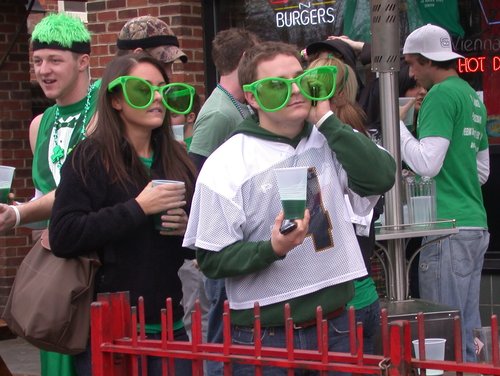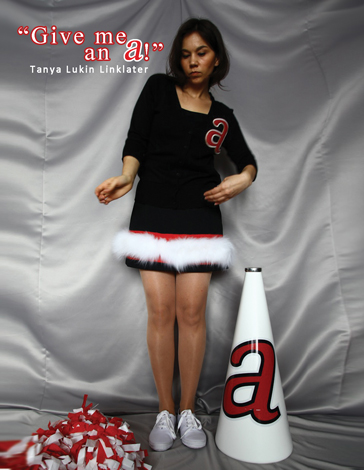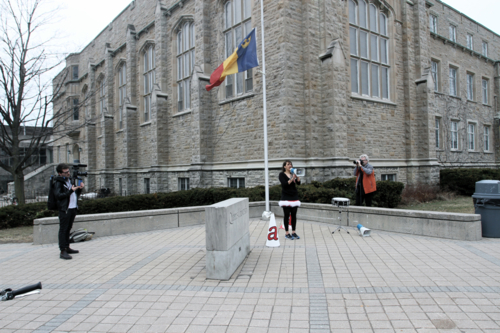Random
The Public Performance of Art
Yesterday, I went to this really amazing performance art thing.
Yesterday was also St. Patrick’s Day, an international day of drunken publicly-performed assholery.
 Both are public performances, but only one is considered art.
Both are public performances, but only one is considered art.
Is the art one considered art because it is intentionally performed? Isn’t drunkenness also intentionally performed?
Let me “set the stage” for both performances, which happened simultaneously yesterday.
For Aboriginal Awareness Week, Tanya Lukin Linklater performed “Give me an A,” which used the artifice of cheerleading as a way of speaking of/about/towards/around indigenous identity and its co-optation:
The cheerleader is an intermediary or conduit, rallying a crowd through chants, cheers, dance routines & jumps, directing the attention of the crowd to sports-related spectacle. Similarly, Alutiiq (Alaska Native) dancers are conduits who rally community members through song, dance, and Alutiiq language to engage with cosmology.
She wore a modified cheerleading uniform. She had a two megaphones, pom-poms, a loud speaker, and a snare drum. She began the performance by standing in silence. Then, she did something like an interpretative dance. Her movements were fluid, nothing like cheerleading, which is focused on the beat and the creation of lines and perpendiculars. Then, she breathed into a megaphone. When she spoke, she spoke in her native language, mostly through the loudspeaker. The only time she spoke English was at the very end, when she yelled through the loudspeaker, “Give me an A!” repeated several times. Then, she prodded us, “What does that spell?” The obvious answer was “A.” She incorporated components of cheerleading in order to highlight her performance of indigeneity.
The performance took place at an intersection in the heart of campus. On any regular day, she would have attracted the usual Lefty crowd and any walker-by. The walkers-by would be interested for a few minutes. Then, they would’ve gone about their day. But yesterday was not any day: it was St. Patrick’s Day.
Having come from South Bend, Indiana, I didn’t think any performance of drunkenness would surprise me, much less on St. Patty’s Day, but yesterday, the display of public drunkenness seemed more severe than the most rowdy Notre Dame football game (a space that requires constant and extreme intoxication). As Tanya performed, drunken undergrads heckled her. Several tried to “interpretative dance” with her. Her silences were interrupted with bellows and chides. (Before the performance began, one poor guy dropped a whole container of poutine. In front of maybe ten people and a few cameras, the guy started eating it off the sidewalk. Then, he scooped it back into the container and went on his way.) At the height of her performance, Tanya engaged a group of drunkards by yelling at them through the loudspeaker across the street. She was clearly chastising them. They yelled back something about how they didn’t deserve her witchcraft voodoo. They yelled something back about how they never did nothing to their mamas. Although there was a firm “line” around Tanya during her performance, many people tried to run through to interrupt her. Or, maybe, just to get a little attention.
I don’t think anyone was being racist. No one was trying to interrupt her performance because she’s indigenous. The drunk students would have acted the same way to anyone doing any kind of performance.
Drinking and being drunk is a bonding experience. No one would dispute this.
What I’m curious about is the way these two forms of performance were documented and experienced. Is drunkenness is a public performance? Or, rather, is the extreme drunkenness displayed on St. Patty’s Day a public performance? Is it art? The public performance of drunkenness pushes the boundaries of what is socially acceptable. By intentionally becoming drunk, there seems to be an active choice in losing control. Maybe “losing control” is too harsh, but you get what I mean.
Can public displays of insobriety be considered performance art?
I have to admit: Tanya’s performance made me uncomfortable. I’m hyper-vigilant against anything I consider “New Age”ish, and the swaying of body is something I often equate with the New Age. At the beginning of the performance, especially as drunk people were walking by and interrupting her, I was super uncomfortable. But let me tell you, the moment she spoke, I was hooked. I don’t want to sound cliché, but I actually got chills. At one point, she began singing. It was beautiful. Almost transcendental. (It was really cold yesterday, and for a few minutes, she had me so captivated that I forgot to be bitter about the wind and temperature.)
There were three video cameras there, professional-ish. It was a big deal. Tons of people were taking pictures. Here’s one:
So what Tanya was doing was legitimately called “art.”
But is there a difference between her performance and the performance of a group of drunken students, who caught up in the herd mentality enact a version of drunkenness that is more extreme and more performative than what they actually feel?
Or, maybe I’m just jealous because I don’t drink. (I can’t drink. I’m allergic. But if I weren’t, I imagine I’d make an excellent drunk.) I will never feel the camaraderie that the students felt yesterday. The most I can do is fake it, which is what I often do in party situations. Of course, isn’t that as much an act of performance art as anything else? Who and what sanctions certain things as art and certain things as deviant or improper behavior? I don’t know. Someone help me out here.
Tags: performance art



s’all abt putting urinal in museum vs. pissing in the street; these two worlds shall never collide.
“Who and what sanctions certain things as art and certain things as deviant or improper behavior?”
Congressional Republicans. At least in the U.S.A.
Does anyone else know what Poutine is?
it is now hyperlinked.
it is now hyperlinked.
putang in french
haha. jimmy chen wins again!
haha. jimmy chen wins again!
bi-winning #winning
bi-winning #winning
arguably since the 70s artists have been trying to actually erase the divide that institutional confines establish (i.e. “this is art because it’s in a gallery/museum”). happenings were basically performative pieces mediated by drinking, performed in public, without being titled many of the ‘living theater’/actions/happenings that were rampant in the decade would probably be percieved as simply public intoxication. (uh, don’t ask me for actual examples right now, i just ate pizza hut breadsticks and i’m in grease-hangover)
arguably since the 70s artists have been trying to actually erase the divide that institutional confines establish (i.e. “this is art because it’s in a gallery/museum”). happenings were basically performative pieces mediated by drinking, performed in public, without being titled many of the ‘living theater’/actions/happenings that were rampant in the decade would probably be percieved as simply public intoxication. (uh, don’t ask me for actual examples right now, i just ate pizza hut breadsticks and i’m in grease-hangover)
There was a performance artist in the 70s (as mentioned above my memory is erased right now so I, of course, cannot remember who) who made a video art piece in which she (I think it was a she) simply sat in front of a video camera and drank shots of vodka (or some other alcohol) until she was blacked out.
I think the difference can be found more in intention than in presence of alcohol. I have turned boring parties with strangers into “performance art” by getting drunk &, with the assistance of a friend, inventing a wildly adventurous narrative to impart upon unsuspecting drunk people (the performativity here depended both upon my “looseness” while drunk & the inebriation of the audience– obviously people are [arguably] more gullible/open to the fantastic when they aren’t sober). The idea is then to get the information to spread throughout the party until you’ve created your own personal (and entirely fabricated) mythology. Was this art or was it just me fucking around to have fun? Well, since I was an art student, for me it was both.
shaun gannon introduced me to poutine during awp. the restaurant we got it from called it “hobo fries.”
First thought: whoever planned an outdoor art happening on St. Patrick’s Day is an idiot. Second thought: performance art is almost always a disruption of some sort, so disrupting the disruption is kind of interesting (in the abstract at least). Third: there’s definitely something to be said for carnivalesque scenarios creating an atmosphere where altered/heightened/extreme thoughts/actions/feelings are possible, from impaling babies on pitchforks to eating slop off the street. Last: given the terrible effect alcohol has had on so many indiginous communities, I find this sad on so many levels.
As M. Kitchell said, it’s primarily a matter of intent. There is an ever growing trend to proclaim that anything can be art, either as an attempt to raise up something the declarer enjoys or else to degrade what some view as an elite establishment. But there has to be a defining line (hazy as it is destined to be) between art and not-art.
If anything can be art then everything can be art and if everything is art then it’s a superfluous term and there’s no point in discussing it. (The same holds true to the notion that nothing is art.) If everything is art then everyone is an artist and to designate oneself an artist is also superfluous.
Art is either beautiful or interesting or provocative (or some combination of the three, each held in the eye of the beholder.) But not everything beautiful or interesting or provocative is art. I’ve seen many natural rocks that I found beautiful or interesting (but not provocative, that I can recall) but I wouldn’t call them works of art. (If there is a divine being who personally crafted that rock to provide beauty to the world, then I will concede that it is a work of art.)
Could a drunken St. Patrick’s Day mob constitute art? Potentially, but there would have to be some purpose behind it, some intent.
On an unrelated note, I would dispute that drinking and being drunk is a bonding experience. At best, it can give the temporary illusion of bonding but that bond is almost guaranteed to break the next morning. At worst, it’s quite the opposite of a bonding experience. (I say this as someone who suffered from social anxiety for many years and is much more personable drunk.)
I would consider St. Patrick’s Day tomfoolery as a ritual in our current cultural mythology. I don’t know how self-aware the average person is while participating in it. I think it could be “performance art” if someone was sufficiently self-aware of themselves as performing a role a ritual. I don’t have a self-awareness-scale at my disposal though. Catholic Mass as performed by the devout vs as performed by atheist actors?
yah i get the ‘happening’/’public’ thing, just saying i like my art in museums so i can see it, get the postcard in the museum store, and step back into the ugly world
with the exception of J Chen, I think the commenters here should chill the fuck down and crack a brew. Jeez.
the only difference is hobo fries use melted mozzarella cheese, poutine uses cheese curds. also i am sort of grossed out by the idea of cheese curds having not eaten them before, while melted mozzarella makes me salivate in my face
art? pff thats for fags let’s fucken bro out man
lol
yeah, cheese curds sounds weird. it’s turd with a c.
vipshopper.us
url.rexbd.net/?id=14553
People should probably stop worrying about what is and isn’t art and just do “stuff.”
I would argue that “intent” is way too slippery for it anchor/determine whether something is considered artistic or not.
that is great advice!
but I am both interested in “stuff” and ignorant about “stuff”, and want to understand and, if possible, to orgasmize my interaction with “stuff”
what is “stuff”?
how can you tell “stuff” from things/acts that are not “stuff”?
how do you evaluate “stuff”?
is “stuff” worth anything beyond making a “stuffist” feel good or become richer, or is it just indulgent and ultimately ineffective bullshit?
if not, why not??
Hehe. Well, I guess what I was trying to get at, or rather, what I should have made clearer, is that while arguing about what “is” and “isn’t” art is fun, and probably a healthy activity, I find that a lot of people throw around a lot of the same answers, most of which are tethered to something that could be considered legitimate. I guess I just find a lot conversations regarding whether something is “valid” art or not sort of boring — which I suppose doesn’t mean people should stop talking about it, but doing “stuff” and avoiding those arguments is probably OK too.
lily one way to get ahold of the “art” question(s) here might be to distinguish between performance and public behavior.
Now, these categories overlap: all “behavior” is “performance” in the sense of being the epiphenomenal effect of filtered drives, and “performance” is always ‘behaved’.
But in the practical (and everyday) sense of the word, a “performance” is ‘an attempt to transform someone else (as well as oneself)’, not merely ‘to act in gratification of one’s drives’. The person(s) in and behind a “performance” intends ‘to disclose “world”‘ (a sign and meaning of poetry), while the person(s) in an act of public “behavior” intends the imposition of drive, perhaps with the effect of expressing power, but without any receptive participation on the part of the behaver.
(Of course, all the interesting words in the previous paragraph can be interrogated out of useful existence, but, I think, not usefully so.)
There’s always the chance – the opportunity – of a non-intentional (at least, to my awareness) ‘disclosure of “world”‘: an autumn gust of wind knocks most of the leaves out of a tree, or a cloud is mirrored in a building’s windows, or someone in a bus stop brushes the hair out of their eyes, or etc. – everyone experiences uncannily epiphanic moments when disparate feelings and thoughts come together as a ‘meaning’ in a gesture of fact. But, in a “performance”, the illumination or discovery, while not perfectly anticipated, is somehow planned; in an act of public “behavior”, like drunken heckling of a “performance”, whatever is learned or otherwise gained by spectators is not so in the manner of communicative interaction.
–
Looking at this discussion, I see lots of my own qualifications and even objections – not to the distinction, but to its elaboration. Well, that’s normal, ha ha.
ha ha* on me
*See my boring comment below.
Most of the cultural activity you are referring to as performance art is indistinguishable from the efforts many people make when they get appear and act in public. Consumption through various activities seems to be where creativity has migrated for most people, whether they are consuming clothes, food, booze, books, or some other commodity that we now understand as part of the information feast, or whether they displaying a consumption of information as information, as generally happens here and elsewhere on the web. Identity-formation itself has always been an art, and now we are growing more aware of it; those of us more inclined to flatter ourselves on account of our self-awareness may find it easy to look down on those who participate in identity-forming rituals with a certain laziness or even mindlessness. But then blogging to make critical insights and then signing your name isn’t all that different, either.
http://shortlinks.co.uk/36yj